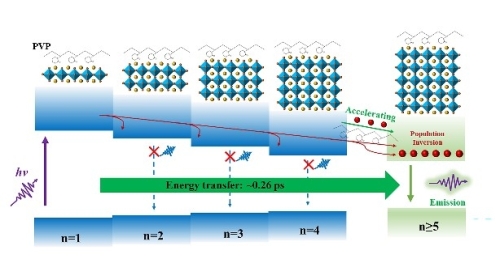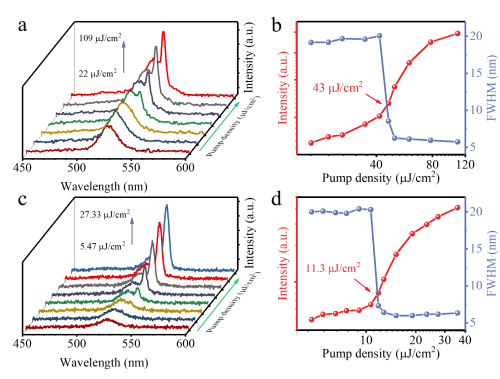A collaborative research team led by Shanghai Institute of Optics and Fine Mechanics (SIOM) of the Chinese Academy of Sciences (CAS) and, Huazhong University of Science and Technology facilitated the energy transfer process by manipulating the phase distribution in the two-dimensional perovskite, thereby improving the gain performance and achieving a low-threshold amplified spontaneous emission (ASE). The work entitled “Enhanced amplified spontaneous emission in quasi-2D perovskite by facilitating energy transfer” was published in ACS Applied Materials & Interfaces on July 13, 2022.
Quasi-2D perovskites with natural quantum well structures have outstanding potential to realize low-cost miniaturized lasers as gain media due to their superior environmental stability and enhanced photon confinement ability. However, the mixed phase distribution in heterogeneous quasi-2D perovskites is an important issue affecting the exciton energy transfer efficiency. Precise control of the gradient phase distribution in mixed-phase quasi-2D perovskites is critical for realizing an efficient energy funnel process from high-energy to low-energy bands.
Based on the above problems, the researchers accelerated the energy transfer process by introducing a polymer compound additive (polyvinylpyrrolidone) to achieve the enhanced emission properties of quasi-two-dimensional perovskites. The additive can be well combined with the perovskites, and chemically interact with the surface of the perovskite through the C=O of the amido group, effectively improving the nucleation and crystallization process of the quasi-2D perovskite.
By ultrafast transient absorption experimental analysis, researchers found that the additive can effectively accelerate the energy transfer process of quasi-2D perovskite, suppress the incomplete energy transfer and nonradiative recombination of the low-dimensional phase, and further promote the establishment of the gain process. Finally, after additive treatment, the ASE threshold is only a quarter of that of pristine quasi-2D perovskite films under 400 nm pulsed laser excitation.
This work presents an efficient strategy to enhance the low-threshold ASE performance of quasi-2D perovskites and provides a simple and feasible solution for designing high-performance perovskite-based laser devices.

Figure 1. Schematic of energy transfer process in quasi-2D perovskite film. (Image by SIOM)

Figure 2. ASE spectra for (a) pristine and (c) PVP-treated film under 400 nm fs-laser excitation. The dependence of the output intensity and FWHM as a function of pump density for (b) pristine and (d) PVP-treated perovskite film. (Image by SIOM)
Article website:
https://doi.org/10.1021/acsami.2c07633
Contact:
WU Xiufeng
General Administrative Office
Shanghai Institute of Optics and Fine Mechanics, CAS
Email: xfwu@siom.ac.cn
Web: http://english.siom.cas.cn/